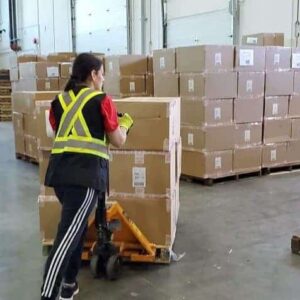In today’s world of personalized products, custom labels and tags play a crucial role in branding, identification, and decoration. From fashion garments to handcrafted items, having unique and high-quality labels can significantly enhance the appeal and professionalism of your products. This is where embroidery digitizing services come into the picture. They help transform your designs into beautiful, durable embroidered labels and tags that stand out. In this guide, we’ll explore the vital role of embroidery digitizing in creating custom labels and tags and how it can benefit your business.
Understanding Embroidery Digitizing Services
What is Embroidery Digitizing?
Embroidery digitizing is the process of converting a design or artwork into a digital file that an embroidery machine can read and stitch. This involves mapping out the design into a series of stitches, specifying the type, length, and direction of each stitch to create a precise and detailed embroidery.
Why Use Embroidery Digitizing for Labels and Tags?
Embroidery digitizing ensures that your labels and tags are produced with the highest level of accuracy and consistency. It allows for intricate designs to be translated into embroidery, capturing fine details and ensuring durability.
Benefits of Embroidered Labels and Tags
1. Durability and Longevity
Embroidered labels and tags are incredibly durable. Unlike printed labels, they do not fade, peel, or wear out quickly. This makes them ideal for garments and products that undergo frequent washing and handling.
2. Professional Appearance
Embroidered labels give your products a polished and professional look. They add a touch of elegance and sophistication that can elevate your brand’s image.
3. Customization and Uniqueness
With digitizing for embroidery, you can create highly customized labels and tags that reflect your brand’s identity. Whether it’s a logo, text, or intricate design, the possibilities are endless.
Steps to Create Custom Embroidered Labels and Tags
1. Designing Your Label or Tag
The first step is to create a design for your label or tag. This can include your brand’s logo, name, or any other elements you want to incorporate. Make sure the design is clear and high-quality.
2. Choosing the Right Materials
Select the fabric and thread for your labels and tags. The choice of materials will depend on the intended use and desired look. Common options include cotton, polyester, and satin for the fabric, and polyester or rayon for the thread.
3. Digitizing the Design
Send your design to a professional embroidery digitizing service. They will convert the artwork into a digital embroidery file, optimizing it for stitching on the chosen fabric and ensuring all details are captured accurately.
4. Embroidering the Labels
Once the design is digitized, it’s time to embroider the labels. This is done using an embroidery machine that follows the digital file to stitch the design onto the fabric.
5. Cutting and Finishing
After the embroidery is complete, the labels are cut to size and finished. This can include adding backing, hemming edges, or incorporating adhesive for easy application.
The Importance of Professional Embroidery Digitizing Services
1. Precision and Accuracy
Professional digitizing services ensure that your design is converted with precision. They understand the nuances of different stitch types and how to adjust them for various fabrics, resulting in high-quality embroidery.
2. Time and Cost Efficiency
Using a professional service saves time and reduces the risk of errors. They have the expertise and tools to digitize designs quickly and accurately, which can be more cost-effective than doing it yourself.
3. Access to Advanced Tools and Techniques
Professional digitizers use advanced software and techniques to optimize your design. This includes adjusting stitch density, underlays, and thread colors to ensure the best possible outcome.
Tips for Creating High-Quality Embroidered Labels and Tags
1. Keep It Simple
For small labels and tags, simpler designs tend to work better. Intricate details may get lost or look cluttered, so opt for bold, clear elements that are easy to read and recognize.
2. Use High-Quality Materials
Invest in high-quality fabrics and threads. This not only ensures durability but also enhances the overall appearance of your labels and tags.
3. Test Your Design
Before producing a large batch, test the design on a sample fabric. This allows you to make any necessary adjustments and ensure the final product meets your expectations.
4. Pay Attention to Size and Placement
Consider the size and placement of your labels and tags. They should be proportionate to the product and positioned in a way that is both functional and aesthetically pleasing.
Common Challenges and How to Overcome Them
1. Dealing with Small Text and Details
Small text and intricate details can be challenging to embroider. Work with your digitizing service to simplify these elements without losing the essence of your design.
2. Ensuring Consistency Across Batches
Consistency is key for branding. Using professional digitizing services ensures that each label and tag is produced to the same high standard, maintaining uniformity across batches.
3. Choosing the Right Colors
Color matching can be tricky in embroidery. Provide your digitizer with specific color codes or samples to ensure the thread colors match your brand’s palette accurately.
Conclusion
Custom embroidered labels and tags are a fantastic way to enhance your brand’s image and add a professional touch to your products. By leveraging the expertise of embroidery digitizing services, you can create durable, high-quality labels that stand out. From design to production, every step plays a crucial role in achieving the perfect embroidered label. Invest in professional digitizing to ensure your designs are optimized for embroidery, and enjoy the benefits of long-lasting, beautifully crafted labels and tags.
FAQs
1. What are the advantages of using embroidered labels over printed ones?
Embroidered labels are more durable and long-lasting compared to printed labels. They do not fade or peel, maintaining their appearance over time.
2. How can embroidery digitizing services help in creating custom labels?
Embroidery digitizing services convert your design into a digital file that embroidery machines can read, ensuring precision and accuracy in the final embroidered label.
3. What materials are best for embroidered labels and tags?
Common materials include cotton, polyester, and satin for the fabric, and polyester or rayon for the thread. The choice depends on the desired look and durability.
4. How do I ensure my embroidered labels are consistent across batches?
Using professional digitizing services and high-quality materials ensures consistency. Testing the design on sample fabrics before mass production can also help.
5. Can small text and intricate details be embroidered effectively?
While small text and intricate details can be challenging, working with a professional digitizing service can help simplify these elements without losing the essence of the design.


